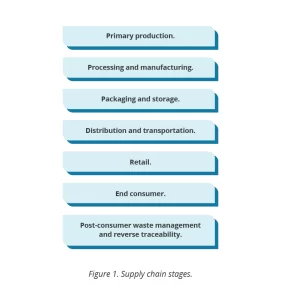
A product lifecycle approach to food safety
Authors: D. Peña and C. Valenzuela
In a world where food safety has become a global commitment that involves protecting consumer health, optimizing resources and ensuring the sustainability of the food supply chain, it becomes necessary to adopt an approach based on the life cycle of food products.
What is product life cycle-based food safety?
Food safety based on the life cycle of the product is consolidated as a strategic approach that allows the identification and control of hazards from primary production to final consumption. The life cycle of a food product is considered to cover all stages (Figure 1), from the procurement of raw materials to the final consumer and even the disposal of waste.

Each of these stages entails microbiological, chemical and physical risks that must be identified, evaluated and controlled in a systematic manner.
Why is it relevant to apply this approach?
· Applying this approach allows organizations to:
· Identify emerging hazards that might go unnoticed in a traditional analysis.
· Implement more effective controls by understanding the origin and trajectory of each input.
· Increase traceability and consumer confidence.
· Contribute to sustainability by reducing waste and environmental risks.
· Some international standards such as ISO 22000, FSSC 22000 or BRCGS already integrate a broader vision of risk management, which is aligned with life cycle analysis.
How does it contribute to supply chain sustainability?
· By applying a life-cycle approach, it is possible to:
· Reduce avoidable losses in production and processing.
· Design more robust processes that minimize rejections.
· Improve inventory management and stock turnover.
· Strengthen traceability, avoiding unnecessary discards in the event of incidents.
· Educate the consumer about conservation practices and consumption dates.
Tools for its implementation.
· To implement this approach effectively, it is critical to integrate tools such as:
· HACCP and risk analysis extended to the full cycle.
· Traceability and proactive recall systems.
· Good manufacturing practices (GMP) and storage.
· Product life cycle management with an environmental and safety approach.
· Protocols for safe reuse or donation of safe products.
· Internal and external awareness campaigns on waste.
Taking a holistic view based on the life cycle transforms the way organizations approach food safety: it is no longer seen as a set of isolated controls and becomes a living, connected system, where every decision, from field to fork, has an impact on product safety.
References.
M. L. Yulexis. Food life cycle analysis including food safety categories. Universidad Central de las Villas. Department of chemical engineering.
